After an uneven first half of the season, The Acolyte seems to have found its voice and a satisfying rhythm. Last week, the plot slowed down and characters were reshuffled a bit after they were shaken to the core in the fantastic fifth episode (Qimir is doing fine though). With episode 7, the show finally unveils what really happened 16 years ago on Brendok, and the line between good and evil feels even more blurred.
There’s plenty of satisfaction to be found in a narrative that doesn’t fully come together until its later stages, yet we remain convinced things could’ve been handled a bit better early on. While the story is convincing and refreshing at the moment, there’s a widespread feeling that the earlier episodes could’ve been more engaging in spite of all the information that was withheld from viewers. If you stuck around hoping for an improvement, you’re likely to be very happy now, but we can see why many fans bounced off.
‘Choice’ not only answers our burning questions about the destruction of the witches on Brendok and the moment that Mae and Osha were separated, it also paints a much more complicated picture of the Jedi that were stationed there and the consequences of some poor decisions on both sides of the conflict. Neither the Jedi nor the witches wanted to battle, and their respective motivations weren’t pure or evil.
First and foremost, episode 7 deals with very human emotions, the kind which are traditionally suppressed by the religious institutions, and the serious consequences that come from decisions that are born out of passion and fear.
Brush up on your Star Wars knowledge by checking out our ranked lists of the best Star Wars movies, Star Wars TV shows, and Star Wars games. Or maybe you’d like to get your hands on the best Lego Star Wars sets? Then you’ll definitely want to keep an eye on the best Lego Star Wars deals in the galaxy to save a whole heap of credits.
Spoilers ahead for The Acolyte episode 7: “Choice”
What are the implications of a vergence in the Force?
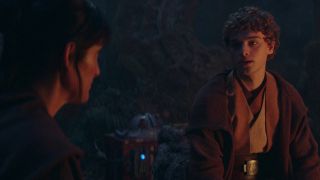
There are two major pieces of Star Wars lore referenced in this episode. The first one is more of a small mention, but explains why the Jedi were on Brendok: the Great Hyperspace Disaster which kicked off the events that marked the beginning of the High Republic-era books and comics. Long story short: a huge freight transport was destroyed while it was travelling through hyperspace, and the resulting debris destroyed several worlds and rendered others inhabitable.
At the beginning of this flashback episode, we learn that the Jedi party of four – Sol, Indara, Kelnacca, and Torbin – are on Brendok to find out how and why life seems to be doing fine on the planet following the aforementioned disaster. Soon enough, the matter of a Force vergence (also known as Force nexus) is brought up. In simple terms, these ‘points’ are unusual yet natural concentrations of Force energy. We’ve seen them before in planets like Mustafar, Dagobah, or Ahch-To, but vergences can also be centered on objects (like the Skywalker lightsaber in The Force Awakens) or, more importantly, people.
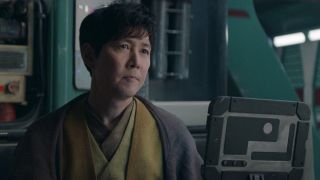
The Phantom Menace had Qui-Gon Jinn saying he’d found a vergence in the Force in a young Anakin Skywalker, who seemingly had no father. Much like life on barren planets, was he created by the Force itself? Episode 3 of The Acolyte toyed with that same idea, suggesting that certain knowledge about the Force and darker teachings could lead to the creation of life. This caused division among fans (shocking, we know), yet it fell in line with George Lucas’ lore dump about Darth Plagueis and the powers that Darth Sidious/ Palpatine (his apprentice) promised Anakin before everything went bad for the talented Jedi.
Leslye Headland and her team’s were wise enough to leave things up in the air when it comes to answering whether the witches were responsible for all the flourishing life on the planet or simply ‘conceived’ the twins as the future of their coven. The ideas presented here are strong enough on their own and are used to great effect to add more mystique to the Force and how both the Jedi and the witches understand and use it. You might think everything needs to be explained, yet going too far down that road has often led to answers that didn’t live up to the larger-than-life mysteries in other franchises, such as Alien.
Were the Brendok witches evil?
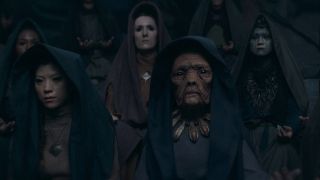
As previously said, neither episodes 3 nor 7 have given us enough reason to consider the witches were wrong or even evil. While the Witches of Dathomir were aligned with the dark side, the Brendok witches’ main objective seemed to be simple: to live in peace far away from the Republic and the Jedi, learning about the Force in ways that were forbidden by the Jedi Order (a strict philosophy that had led to several wars in the past and the creation of the Sith Order).
Of course, the season’s eighth and final episode could turn everything on its head again, perhaps revealing a hidden agenda that Mother Aniseya and/or Koril could’ve had? Or, maybe the influence of a truly dark someone that has stayed behind the curtain? For right now, we’ve seen their only mistake was raising two children in isolation from the rest of the galaxy and choosing the coven’s future (as designed by them) over everything else.
In a way, this is the kind of hubris that led to the Jedi Order’s destruction… and also theirs. In spite of their distinct views on the Force, both groups are irrevocably doomed because of how narrow-minded and proud they are, and that’s one of the main points that Headland and her team are driving home.
While the conflict between the Sith and the Jedi (who ultimately seek peace and justice) is more clear-cut, The Acolyte’s tale is far more complicated. It works with a moral grayness more than most other Star Wars series and movies we’ve seen so far (Andor is its closer relative in this case). However, this kind of religious oppression doesn’t justify Qimir’s murder spree though.
Were Sol and Torbin wrong?
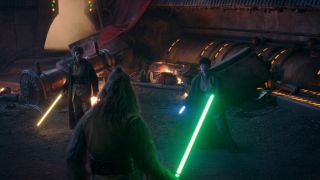
Episode 7 is mainly told from the Jedi Knights’ perspective. In episode 3 of The Acolyte they came across as bullies that were only seeking to take Force-sensitive children away from their family. But, much like in The Last Jedi – a Star Wars movie that clearly had an impact on Headland – the ‘Rashomon effect‘ is a key part of the muddled narrative. Were the Jedi right when they came looking for Mae and Osha? Nope, yet they weren’t entirely wrong either.
In fact, Indara and Kelnacca probably wouldn’t have started a conflict on their own, as they come across as calmer and more professional than Sol and Torbin back then. The former is agitated even before learning about the coven’s existence because, much like Qimir in the series’ present day, he desires to have an apprentice, but he’s seen as too unexperienced to mentor one.
As for Torbin, he’s a Padawan that, like many others before and after him, is still struggling with fear and wants to return to the home he knows (Coruscant in this case). Torbin’s anxieties become a weakness the moment the Jedi set foot inside the witches’ fortress. In an attempt to scare the group off, Mother Aniseya quickly preys on Torbin’s fears (in a very seductive manner, like Qimir employed in the last episode on Osha).
Indara and Kelnacca’s resolve is, however, unbreakable, and Sol is meanwhile dead set on taking Osha home. While we already knew the unmarked twin didn’t want to live in isolation, Sol doesn’t and is letting his emotions dictate actions that could be potentially devastating.

After lying about Osha’s ‘Jedi test’ and disobeying the Council’s orders and Indara’s wise words, Sol and Torbin return to the fortress in order to find and essentially kidnap the twins. For Sol, it’s the perfect opportunity to gain an apprentice. For Torbin, it’s a ticket back to Coruscant, as Mae and Osha appear to be the vergence they were looking for.
Mother Aniseya’s sudden use of magick to protect Mae leads to her own death and the ‘bad’ twin seeking revenge against the Jedi that ruined everything. This also triggers Koril, who was already on edge, to fight Sol and the rest of the coven to possess the imposing Kelnacca. The resulting action sequence reminds us how good this show’s choreography and stunt work is, and really helps elevate director Kogonada’s otherwise flat couple of episodes (the flashback ones).
By and large, ‘Choice’ illuminates most of the leftover plot stuff we needed to figure out before venturing into the finale. Despite this, Mae’s following actions against Osha and the sudden death of seemingly every witch after Indara breaks their connection to the Wookiee Jedi still feel as thin and unconvincing as some of the shakier moments we saw in the early episodes. Moreover, it can be argued that some straight-up repeated moments that give context to the new ‘Jedi point-of-view’ scenes are redundant and underestimate the audience’s memory.
How Qimir (posing as the Stranger) came into contact with Mae after her disappearance is also kept in the dark for now. Chances are that the season 1 finale will be all about the Sith side of the story and Mae and Osha’s fully swapped positions. There’s one big issue though: as much effort as Amandla Stenberg has put into the dual role, the twins aren’t nearly as interesting as the characters that surround them.










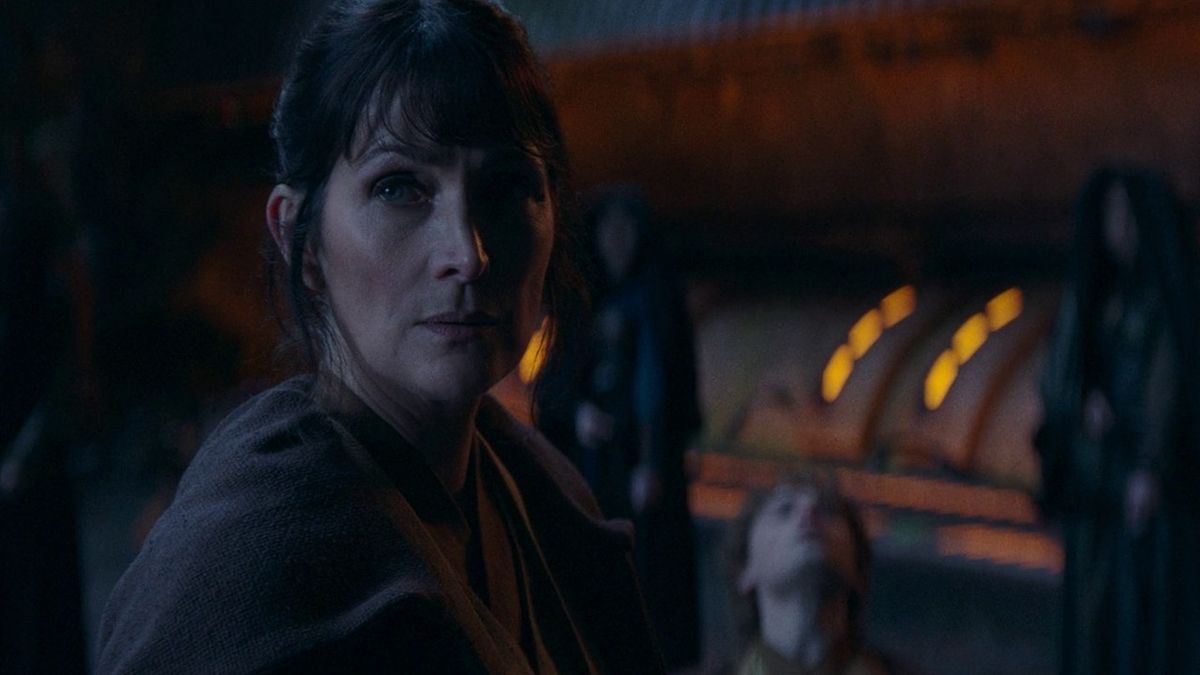
/https://tf-cmsv2-smithsonianmag-media.s3.amazonaws.com/filer_public/34/31/3431771d-41e2-4f97-aed2-c5f1df5295da/gettyimages-1441066266_web.jpg)







Discussion about this post